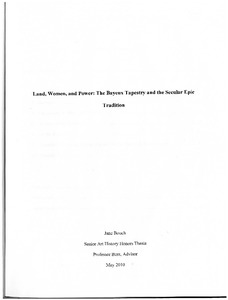| dc.rights.license | In Copyright | en_US |
| dc.creator | Bouch, Jane Crossett | |
| dc.date.accessioned | 2023-04-21T19:30:16Z | |
| dc.date.available | 2023-04-21T19:30:16Z | |
| dc.date.created | 2010 | |
| dc.identifier | WLURG038_Bouch_thesis_2010 | |
| dc.identifier.uri | https://dspace.wlu.edu/handle/11021/36151 | |
| dc.description.abstract | As an artifact and representation of the Anglo-Norman period of English history, the Bayeux Tapestry stands unparalleled. The only surviving work of its kind, the Bayeux Tapestry provides information for scholars with interests as diverse as medieval shipbuilding and animal husbandry. For an art historian, however, the characters and events portrayed in this enormous piece of linen provide clues about the way contemporary society viewed the interactions between different segments of that society, and the way that these people were expected to operate within it. In this thesis, the role of women as it is depicted within the Bayeux Tapestry will be explored in order to show that the Tapestry exists as a thoroughly gendered work of art. The women are not only depicted as being inferior to the men who populate the Tapestry, but they can be seen to occupy certain roles within the pictorial narrative, roles that render them as stock character types rather than straightforward representations of individuals. These stock character types inhabit scenes within the Bayeux Tapestry that take on this same nature; they can be interpreted as recurring episodic units that are found not only in this pictorial epic, but in written epics of the time as well. The Bayeux Tapestry predates the earliest of these surviving epics by decades. I have examined the relationship between these recurring stock episodes in the Bayeux Tapestry and those found in several of the secular epics written during the twelfth and thirteenth centuries in order to put forth a new argument. The Bayeux Tapestry served as an image-based influence upon the development of the secular epic tradition of the centuries that follow, lending structure and content to these fictional, written histories and stories. As these epic tales
influenced the development of the early modem literary tradition in the West, this renders the Bayeux Tapestry an incredibly influential source for written as well as pictorial accomplishments. [From Introduction] | en_US |
| dc.format.extent | 75 pages | en_US |
| dc.language.iso | en_US | en_US |
| dc.rights | This material is made available for use in research, teaching, and private study, pursuant to U.S. Copyright law. The user assumes full responsibility for any use of the materials, including but not limited to, infringement of copyright and publication rights of reproduced materials. Any materials used should be fully credited with the source. | en_US |
| dc.rights.uri | http://rightsstatements.org/vocab/InC/1.0/ | en_US |
| dc.subject.other | Washington and Lee University -- Honors in Art History | en_US |
| dc.title | Land, Women, and Power: The Bayeux Tapestry and the Secular Epic Tradition | |
| dc.type | Text | en_US |
| dcterms.isPartOf | WLURG38 - Student Papers | |
| dc.rights.holder | Bouch, Jane Crossett | |
| dc.subject.fast | Bayeux tapestry (Title) | en_US |
| dc.subject.fast | Hastings, Battle of (England : 1066) in art | en_US |
| dc.subject.fast | Women in art | en_US |
| local.department | Art History | en_US |
| local.scholarshiptype | Honors Thesis | en_US |
